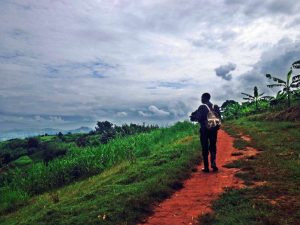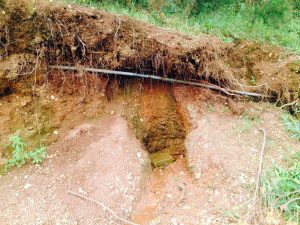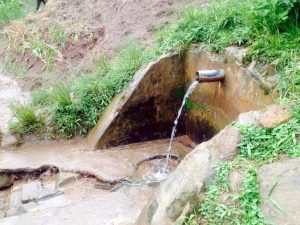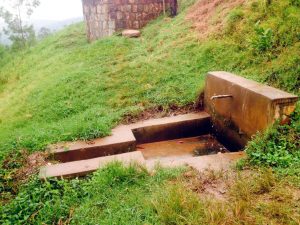This project is made possible through the partnership of WATER CHARITY and the NATIONAL PEACE CORPS ASSOCIATION. ![]()
 Location
Location
Bweramvura and Gitinda Cell, Kinihira Sector, Ruhango District, South Province, Rwanda
Community Description
Bweramvura and Gitinda cells are located within Kinihira sector, in the district of Ruhango, Southern province of Rwanda. Bweramvura cell contains six villages: Kabadende, Bugarura, Gihororo, Gahororo, Nyagisenyi, and Nyabivumu.
Gitinda cell contains nine villages: Muremure, Nyamagana, Rubona, Remera, Nyarugunga, Nyagatovu, Rugarama, Kabasanzu, and Nyarusange.
The Nyabarongo and Kiryango Rivers run through the West and East, creating a border between the Karongi district and the Mwendo sector respectively. Much of the landscape of the area is filled with rolling hills with fertile soil, ideal for farming. There are also many small forests where the trees are cut and used for charcoal and plywood. The hills also boast the shiny mineral mica, commonly called “corta” by the community.
The climate in the region ranges from mild to cool. The rainy season is from February to June and October to December. The dry season is from June to September and December to February.
The community is very rural and not easily accessible. The nearest “town” is one hour by motorcycle taxi, but many community members cannot afford the transport. In the cells, there is one school (primary to senior-level three), a health center, three small boutique stores, an agronomy/veterinary store, and three churches (Catholic, Adventist, and Protestant).
 Many of the villagers practice farming as their main trade, as a majority of the land is farmland. The community is tight-knit, and it seems as though everyone knows everyone.
Many of the villagers practice farming as their main trade, as a majority of the land is farmland. The community is tight-knit, and it seems as though everyone knows everyone.
The Muremure Health Center provides for the health needs of the residents of the sector.
Problem Addressed
There is a great need to improve the water infrastructure in the community. Many people have to walk 30-60 minutes one way to fetch water from the local source, usually one water tap per village. Some families live closer to a river than the water tap, and, therefore, use the unclean river water as their source. This, of course, leads to some of the hygiene-related illnesses we see in young children.
The improvement of water access and WASH education in the community was found to be a priority when the community needs assessment was conducted. A majority of the community members mentioned that they have to walk very far distances to reach their water source, and also that parasites and diarrhea are big health concerns, especially in young children.
At the health center and its near vicinity, there are disruptions in water flow because of numerous damaged and leaking pipes due to heavy rains in the area that have caused erosion and displaced the pipes above ground. Currently, there are no functioning sinks or hand washing stations at the health center for patients or other community members to use. The sinks in place do not work, are very rusty, which causes blockages, or are badly leaking.
 Project Description
Project Description
This project addresses the water needs of the community through three components:
(1) The first priority is to repair the damaged water pipes in the area.
(2) The second will be to repair the sinks and build simple hand washing stations at the health center for staff and patients for regular use.
(3) Thirdly, one new water tap will be constructed in each of 14 villages that have insufficient access for community members.
An important aspect of the project is behavior change, which will come from an educational component throughout the project. Community health workers will be trained on water, sanitation, and hygiene topics and apply these to their work and share with the community during home visits and village meetings. This will teach and encourage households to practice safe water drinking and storage, maintain hygienic homes and kitchen areas, and prevent and care for hygiene-related illnesses.
The project was planned by the health center supervisor, the PCV, the nutritionist (counterpart to the PCV), the community health worker manager, and the technician. Together, they went to visit each site where the pipes were damaged and prepared a detailed budget.
The health center technician will manage the construction of the water taps and repairs of the pipes and sinks. He has a detailed estimate of how many workers he will need, the materials, transport, and timeline of the project. First will be to do repairs at the health center and any damaged pipes in the community. Then we will begin the analysis of water tap location with input from community members, followed by the construction.
 During this time, the PCV will monitor the progress and also hold training for community health workers about WASH. Once the construction has reached the halfway point, a committee will be assembled in each village to ensure community support.
During this time, the PCV will monitor the progress and also hold training for community health workers about WASH. Once the construction has reached the halfway point, a committee will be assembled in each village to ensure community support.
A potential challenge will be adhering to the timeline during the rainy season. The heavy rains may halt work for some days, or may even cause mudslides in the areas of construction.
This project builds skills and capacity in the community in several ways. Training community health workers in WASH topics will broaden their expertise in health issues and care. Helping community members to build their own handwashing stations will develop all of their skills to keep good hygiene. As all of the workers will be from the community, it will give them a form of village ownership, and they will learn about proper maintenance of water facilities.
Project Impact
10,626 community members will benefit from the project.
Peace Corps Volunteer Directing Project
Shreya Desai
Monitoring and Maintenance
Within each village, there will be a committee that will do monthly checks to ensure proper running of the water taps and determine if there is a need for maintenance of the water taps or pipes. If so, the health center will provide a technician, and the funds will come from the health centers and/or local government budgets.
Comments
The impact of the project will be a reduction in the time it takes community members to fetch water, improved facilities of water access, a decrease in the number of preventable hygiene-related illnesses, and an increase in knowledge of WASH topics within the community. This will result in a reduction in the rates of diarrhea, malaria, intestinal parasites, pneumonia, and other illnesses.
Additionally, this project will support the First 1000 Days program by bringing extensive hygiene and sanitation training to pregnant women and mothers with children under two years of age.
Fundraising Target
$4,800
Funds raised in excess of the project amount will be allocated to other projects in the country.
Donations Collected to Date
$125
ADOPT THIS PROJECT BY CONTRIBUTING THE DOLLAR AMOUNT OF THE PROJECT
Donations of any amount will be appreciated. The full amount will give you “naming rights” if that is something you would like.
Dollar Amount Needed
$4,675